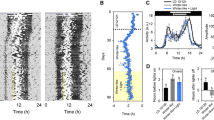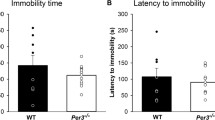Abstract—
A decrease in the light in autumn and winter causes depression like seasonal affective disorders (SAD) in sensitive patients, in which the serotonin (5-HT) and dopamine (DA) brain mediator systems are involved. We studied the interaction of the 5-HT and DA brain systems in an experimental SAD model in sexually mature male mice of the congenic B6-1473C and B6-1473G lines with high and low activity of tryptophan hydroxylase 2, a key enzyme of 5-HT synthesis in the brain. Mice of each line (divided into two groups of eight individuals) were kept for 30 days in standard (14 h light/10 h dark) and short (4 h light/20 h dark) daylight. The presence of the C1473G variant in the tryptophan hydroxylase 2 gene did not affect the expression of key genes of DA system: Drd1, Drd2, Scl6a3, Th, and Comt, that encode the D1 and D2 receptors, dopamine transporter, tyrosine hydroxylase, and catechol-o-methyltransferase, respectively. A decrease in the level of DA in the midbrain, as well as of its metabolite 3,4-dihydroxyphenylacetic acid (DOPAC) in the striatum, was detected in B6-1473G mice. Keeping mice in short daylight did not affect expression of the Drd1 gene in all brain structures nor the expression of the Slc6a3 and Th genes in the midbrain. Drd2 expression increased in the midbrain and decreased in the hippocampus, where Comt expression increased. An increase in DA level in the midbrain and DOPAC in the striatum was detected in mice kept in short daylight. This indicates the involvement of the brain’s DA system in the reaction to a decrease in daylight duration. No statistically significant effect of the interaction between the presence of the C1473G variant and daylight length on indicators of the activity of DA system was detected. No reasons were found to assert that this polymorphism determines the observed reaction of the brain DA system in keeping of animals under short daylight conditions.



Similar content being viewed by others
REFERENCES
Rosenthal E., Sack D.A., Gillin J.C., Lewy A.J., Goodwin F.K., Davenport Y., Mueller P.S., Newsome D.A., Wehr T.A. 1984. Seasonal affective disorder. A description of the syndrome and preliminary findings with light therapy. Arch. Gen. Psychiatry. 41, 72‒80.
Levitan R.D. 2007. The chronobiology and neurobiology of winter seasonal affective disorder. Dialogues Clin. Neurosci. 9, 315–324.
Melrose S. 2015. Seasonal affective disorder: An overview of assessment and treatment approaches. Depress. Res. Treat. 2015, 178564.
Wirz-Justice A. 2018. Seasonality in affective disorders. Gen. Comp. Endocrinol.258, 244‒249.
Lam R.W., Levitan R.D. 2000. Pathophysiology of seasonal affective disorder: A review. J. Psychiatry Neurosci.25, 469‒480.
Neumeister A., Konstantinidis A., Praschak-Rieder N., Willeit M., Hilger E., Stastny J., Kasper S. 2001. Monoaminergic function in the pathogenesis of seasonal affective disorder. Int. J. Neuropsychopharmacol.4, 409‒420.
Cawley E.I., Park S., aan het Rot M., Sancton K., Benkelfat C., Young S.N., Boivin D.B., Leyton M. 2013. Dopamine and light: Dissecting effects on mood and motivational states in women with subsyndromal seasonal affective disorder. J. Psychiatry Neurosci. 38, 388‒397.
Gupta A., Sharma P.K., Garg V.K., Singh A.K., Mondal S.C. 2013. Role of serotonin in seasonal affective disorder. Eur. Rev. Med. Pharmacol. Sci.17, 49–55.
Kulikov A.V., Popova N.K. 2015. Tryptophan hydroxylase 2 in seasonal affective disorder: Underestimated perspectives? Rev. Neurosci.26, 679–690.
Enoch M.A., Goldman D., Barnett R., Sher L., Mazzanti C.M., Rosenthal N.E. 1999. Association between seasonal affective disorder and the 5-HT2A promoter polymorphism, –1438G/A. Mol. Psychiatry.4, 89–92.
Arias B., Gutiérrez B., Pintor L., Gastó C., Fañanás L. 2001. Variability in the 5-HT(2A) receptor gene is associated with seasonal pattern in major depression. Mol. Psychiatry.6, 239–242.
Lee H.J., Sung S.M., Lim S.W., Paik J.W., Kim Leen. 2006. Seasonality associated with the serotonin 2A receptor –1438 A/G polymorphism. J. Affect. Disord. 95, 145–148.
Molnar E., Lazary J., Benko A., Gonda X., Pap D., Mekli K., Juhasz G., Kovacs G., Kurimay T., Rihmer Z., Bagdy G. 2010. Seasonality and winter-type seasonal depression are associated with the rs731779 polymorphism of the serotonin-2A receptor gene. Eur. Neuropsychopharmacol. 20, 655–662.
Levitan R.D., Masellis M., Basile V.S., Lam R.W., Kaplan A.S., Davis C., Muglia P., Mackenzie B., Tharmalingam S., Kennedy S.H., Macciardi F., Kennedy J.L. 2004. The dopamine-4 receptor gene associated with binge eating and weight gain in women with seasonal affective disorder: an evolutionary perspective. Biol. Psychiatry. 56, 665‒669.
Levitan R.D., Masellis M., Lam R.W., Muglia P., Basile V.S., Jain U., Kaplan A.S., Tharmalingam S., Kennedy S.H., Kennedy J.L. 2004b. Childhood inattention and dysphoria and adult obesity associated with the dopamine D4 receptor gene in overeating women with seasonal affective disorder. Neuropsychopharmacology.29, 179‒186.
Osipova D.V., Kulikov A.V., Popova N.K. 2009. C1473G polymorphism in mouse Tph2 gene is linked to tryptophan hydroxylase-2 activity in the brain, intermale aggression, and depressive-like behavior in the forced swim test. J. Neurosci. Res. 87, 1168–1174.
Bazovkina D.V., Lichman D.V., Kulikov A.V. 2015. The C1473G polymorphism in the tryptophan hydroxylase-2 gene: Involvement in ethanol-related behavior in mice. Neurosci. Lett.589, 79–82.
Zhang X., Beaulieu J.M., Sotnikova T.D., Gainetdinov R.R., Caron M.G. 2004). Tryptophan hydroxylase-2 controls brain synthesis. Science.305, 217.
Kulikov A.V., Osipova D.V., Naumenko V.S., Popova N.K. 2005. Association between Tph2 gene polymorphism, brain tryptophan hydroxylase activity and aggressiveness in mouse strains. Genes Brain Behav.4, 482–485.
Walther D.J., Peter J.U., Bashammakh S., Hörtnagl H., Voits M., Fink H., Bader M. 2003. Synthesis of serotonin by a second tryptophan hydroxylase isoform. Science.299, 76.
Bazhenova E.Y., Fursenko D.V., Kulikova E.A., Khotskin N.V., Sinyakova N.A., Kulikov A.A. 2019. Effect of photoperiodic alterations on depression-like behavior and the brain serotonin system in mice genetically different in tryptophan hydroxylase 2 activity. Neurosci. Lett.699, 91‒96.
Otsuka T., Kawai M., Togo Y., Goda R., Kawase T., Matsuo H., Iwamoto A., Nagasawa M., Furuse M., Yasuo S. 2014. Photoperiodic responses of depression-like behavior, the brain serotonergic system, and peripheral metabolism in laboratory mice. Psychoneuroendocrinology. 40, 37–47.
Goda R., Otsuka T., Iwamoto A., Kawai M., Shibata S., Furuse M., Yasuo S. 2015. Serotonin levels in the dorsal raphe nuclei of both chipmunks and mice are enhanced by long photoperiod, but brain dopamine level response to photoperiod is species-specific. Neurosci. Lett.593, 95‒100.
Khotskin N.V., Bazhenova E.Yu., Kulikova E.A., Sorokin I.E., Kulikov A.V. 2019. Effect of C1473G polymorphism in tryptophan hydroxylase-2 gene daylight length on the behavior of mice. Zh. Vyssh. Nerv. Deyat.im.I.P. Pavlova. 69, 85‒94.
Popova N.K., Kulikov A.V., Kondaurova E.M., Tsybko A.S., Kulikova E.A., Krasnov I.B., Shenkman B.S., Bazhenova E.Y., Sinyakova N.A., Naumenko V.S. 2015. Risk neurogenes for long-term spaceflight: Dopamine and serotonin brain system. Mol. Neurobiol. 51, 1443–1451.
Savelieva K.V., Zhao S., Pogorelov V.M., Rajan I., Yang Q., Cullinan E., Lanthorn T.H. 2008. Genetic disruption of both tryptophan hydroxylase genes dramatically reduces serotonin and affects behavior in models sensitive to antidepressants. PLoS One.3, 10.
Alenina N., Kikic D., Todiras M., Mosienko V., Qadri F., Plehm R., Boyé P., Vilianovitch L., Sohr R., Tenner K., Hörtnagl H., Bader M. 2009. Growth retardation and altered autonomic control in mice lacking brain serotonin. Proc. Natl. Acad. Sci. U. S. A.106, 10332‒10337.
Kovaenko I.L., Sagin D.A., Galyamina A.G., Orlov Yu.L., Kudryavtseva N.N. 2016. Changes in the expression of dopaminergic genes in brain structures of male mice exposed to chronic social defeat stress: An RNA-seq study. Mol. Biol. (Moscow). 50 (1), 161–163.
Kudryavtseva N.N., Smagin D.A., Kovalenko I.L., Galyamina A.G., Vishnivetskaya G.B., Babenko V.N., Orlov Yu.L. 2017. Serotonergic genes in the development of anxiety/depression-like state and pathology of aggressive behavior in male mice: RNA-seq data. Mol. Biol. (Moscow). 51 (2), 251‒262.
Galyamina A.G., Kovalenko I.L., Smagin D.A., Kudryavtseva N.N. 2017. Changes in the expression of neurotransmitter system genes in the ventral tegmental area of depressed mice: RNA-seq data. Zh. Vyssh. Nerv. Deyat.im.I.P. Pavlova.67, 113‒128.
Loseva E.V., Sarkisova K.Yu., Loginova N.A., Kudrin V.S. 2015. depressive behavior and monoamine contents in brain structure of rats during chronic overcrowding. Bull. Exp. Biol. Med.159 (3), 327‒330.
Sarkisova K.Yu., Kulikov M.A., Kudrin V.S., Narke-vich V.B., Midzyanovskaya I.S., Biryukova L.M., Folomkina A.A., Bazyan A.S. 2017. Neurochemical mechanisms of depression-like behavior in WAG/Rij rats. Zh. Vyssh. Nerv. Deyat.im.I.P. Pavlova.63 (3), 303‒315.
Loseva E.V., Loginova N.A., Sarkisova K.Yu., Klodt P.M., Narkevich V.B., Kudrin V.S. 2017. Behavioral symptoms of anxiety and depression and brain monoamine contents in rats after chronic intranasal administration of interferon-α. Ross. Fiziol. Zh. im. I.M. Sechenova.103, 417‒431.
Itzhacki J., Clesse D., Goumon Y., Van Someren E.J., Mendoza J. 2018. Light rescues circadian behavior and brain dopamine abnormalities in diurnal rodents exposed to a winter-like photoperiod. Brain Struct. Funct.223, 2641‒2652.
Lonstein J.S., Linning-Duffy K., Yan L. 2019. Low daytime light intensity disrupts male copulatory behavior and upregulates medial preoptic area steroid hormone and dopamine receptor expression in a diurnal rodent model of seasonal affective disorder. Front. Behav. Neurosci.13, 72‒83.
Jackson C.R., Capozzi M., Dai H., McMahon D.G. 2014. Circadian perinatal photoperiod has enduring effects on retinal dopamine and visual function. J. Neurosci. 34, 4627‒4633.
Gutknecht L., Araragi N., Merker S., Waider J., Sommerlandt F.M., Mlinar B., Baccini G., Mayer U., Proft F., Hamon M., Schmitt A.G., Corradetti R., Lanfumey L., Lesch K.P. 2012. Impacts of brain serotonin deficiency following Tph2 inactivation on development and raphe neuron serotonergic specification. PLoS One. 2012. 7, e43157.
Weng R., Shen S., Tian Y., Burton C., Xu X., Liu Y., Chang C., Bai Y., Liu H. 2015. Metabolomics approach reveals integrated metabolic network associated with serotonin deficiency. Sci. Rep. 5, 11864.
Dulcis D., Jamshidi P., Leutgeb S., Spitzer N.C. 2013. Neurotransmitter switching in the adult brain regulates behavior. Science.340, 449–453.
Young W., Cope Z.A., Romoli B., Schrurs E., Joosen A., Van Enkhuizen J., Sharp R.F., Dulcis D. 2018. Mice with reduced DAT levels recreate seasonal-induced switching between states in bipolar disorder. Neuropsychopharmacology.43, 1721–1731.
Ford C.P. 2014. The role of D2-autoreceptors in regulating dopamine neuron activity and transmission. Neuroscience. 282, 13‒22.
Tsai H.Y., Chen K.C., Yang Y.K., Chen P.S., Yeh T.L., Chiu N.T., Lee I.H. 2011. Sunshine-exposure variation of human striatal dopamine D(2)/D(3) receptor availability in healthy volunteers. Prog. Neuropsychopharmacol. Biol. Psychiatry. 35, 107‒110.
Funding
This work was supported by the Russian Foundation for Basic Research (project no. 17-04-00266). The breeding and keeping of animals was supported by the projects nos. 0259-2019-0002 and RFMEFI62117X0015.
Author information
Authors and Affiliations
Corresponding author
Ethics declarations
Conflict of Interests. The authors declare that they have no conflict of interest.
Statement of the Welfare of Animals. The keeping of animals and the experimental procedures complied with the rules of the Council of the European Parliament (Directive 2010/63/EU from September 22, 2010) and were approved by the Bioethics Committee of the Institute of Cytology and Genetics (Siberian Branch, Russian Academy of Sciences) (Protocol no. 16-01-007).
Additional information
Translated by A. Barkhash
Abbreviations: 5-HT, serotonin; DA, dopamine; DOPAC, 3,4-dihydroxyphenylacetic acid; TPH2, tryptophan hydroxylase 2.
Rights and permissions
About this article
Cite this article
Sinyakova, N.A., Bazhenova, E.Y., Kulikova, E.A. et al. Effect of the C1473G Polymorphic Variant of the Tryptophan Hydroxylase 2 Gene and Photoperiod Length on the Dopamine System of the Mouse Brain. Mol Biol 54, 51–58 (2020). https://doi.org/10.1134/S0026893320010148
Received:
Revised:
Accepted:
Published:
Issue Date:
DOI: https://doi.org/10.1134/S0026893320010148




